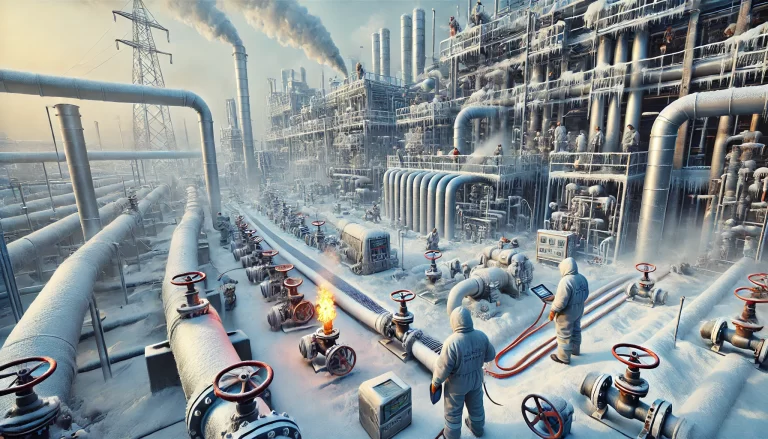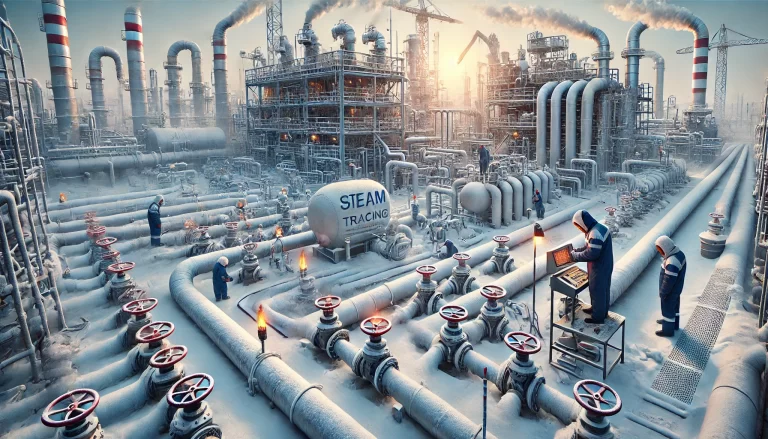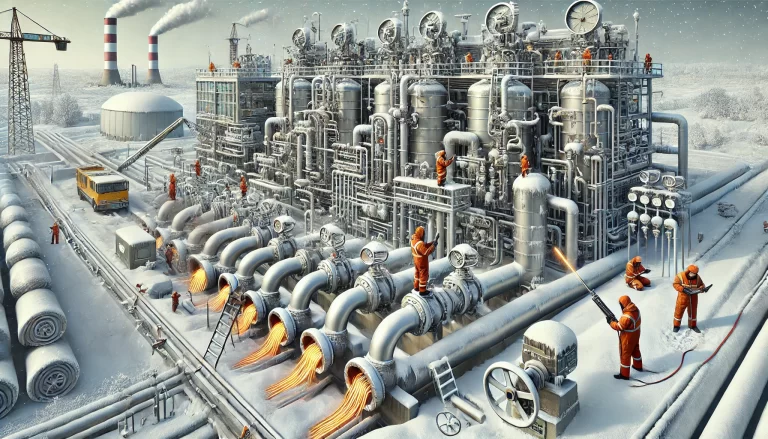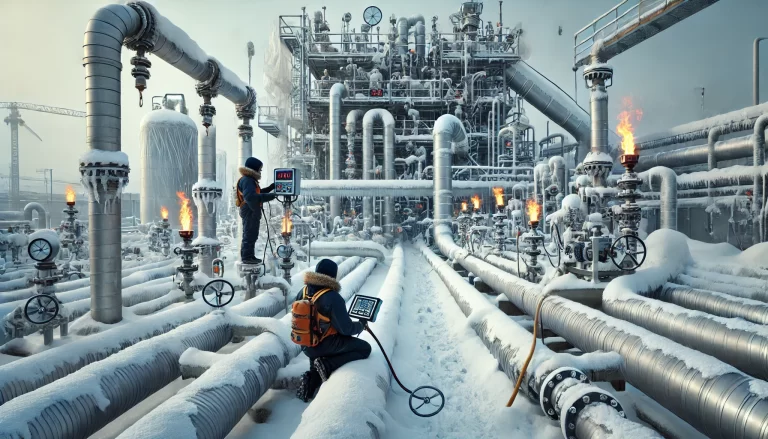The common methods for anti-freezing and anti-condensation in chemical plants include drainage, insulation, heat tracing, and circulation. Winter anti-freezing and anti-condensation should be implemented based on the operating status of the equipment and pipelines, combined with the issues and experiences encountered in previous winters, and adopting one or more of these methods.
1. Drainage The drainage method for anti-freezing and anti-condensation can be roughly divided into three categories:
The first category is for equipment and pipelines that operate intermittently or are not in use for long periods. The drainage process can be done as follows:
- Close the relevant valves and, if necessary, add a blind plate to prevent internal valve leakage.
- Open the high-point vent valve and the low-point drain valve to drain the material inside the equipment.
- Purge and displace any residual material with nitrogen.
- Keep the low-point drain valve open and perform regular checks.
The second category is for facilities and pipelines inside underground valve wells, mainly unheated fire protection facilities (such as water cannons and fire hydrants). The root valve should be closed inside the valve well, and the water above the valve should be drained through the drain valve. Keep the drain valve open, and the fire cannon head should be pointed downward.
The third category is for temporarily used equipment, pipelines, or hoses. After use, the medium inside the pipes should be drained promptly, and the pipes should be purged and cleaned with nitrogen. If possible, they should be stored in a heated building.

2. Insulation From the perspective of anti-freezing, insulation in chemical plants mainly involves the following three aspects:
The first is the insulation of equipment, pipelines, and their accessories with thermal insulation materials. Before winter, issues from previous years should be thoroughly inspected and rectified. Special attention should be paid to equipment and pipelines that rely solely on the material temperature for anti-freezing and lack heat tracing. Ensure the insulation is properly applied, especially at the ends of pipelines, blind ends, and pressure gauges on-site.
The second aspect is maintaining the insulation of indoor spaces like plant buildings. Check whether doors, windows, and curtains are intact, and ensure the heating system inside the plant is activated in time.
The third is sealing and insulating underground valve wells. Use plastic sheeting for sealing in advance and apply insulation if necessary.
3. Heat Tracing For winter anti-freezing, common heat tracing media include hot water, steam, and electric heat tracing. Hot water heat tracing is suitable for conditions where the operating temperature is not high or where high-temperature heat tracing is not feasible. Steam heat tracing is generally used for pipelines where the medium’s operating temperature is below 150°C. Electric heat tracing is not only suitable for situations where steam heat tracing is used, but also for temperature-sensitive media pipelines, as it can effectively control the temperature and prevent overheating. Electric heat tracing is especially useful for dispersed or remote pipelines and irregularly shaped equipment.
The selection of heat tracing media should take into account the properties of the material, operational requirements, construction difficulty, and operating costs, and should be performed according to standards to avoid new problems while achieving the goal of anti-freezing and anti-condensation.
4. Circulation Circulation for anti-freezing and anti-condensation is mainly used for equipment and pipelines that operate intermittently or are not in use for long periods and do not use the above methods (drainage, insulation, heat tracing) for anti-freezing, or where the above methods are insufficient to meet anti-freezing requirements. There are roughly four ways to implement circulation:
The first is to recirculate the material from the outlet of the operating equipment back to the inlet of the standby equipment. This method is commonly used for standby moving equipment to prevent freezing and condensation, such as bypassing the check valve at the pump outlet or drilling holes in the check valve core.
The second is to connect the inlet and outlet pipelines of the equipment, mainly used for preventing freezing in the pipelines of idle heat exchangers. A smaller diameter pipeline is connected before the inlet valve and after the outlet valve of the heat exchanger to maintain circulation in the inlet and outlet pipelines.
The third is to circulate a small amount of material in a normal operating mode. Typically, the outlet valve of the standby equipment is closed as much as possible to reduce the amount of material circulating, while still meeting anti-freezing requirements.
The fourth is to continuously or intermittently discharge a small amount of material, mainly for pipeline ends where it is impossible to establish circulation. Examples include hose stations, dewatering pipelines, and valves for tanks, low-point drain valves for steam pipelines, and eye washers.

Anti-freezing Inspections
Anti-freezing inspections are a crucial part of the winter anti-freezing work. Regular inspections help identify and address problems in time, preventing the escalation of freezing and blockage issues. Anti-freezing inspections mainly involve checking the effectiveness of the anti-freezing and anti-condensation measures, identifying gaps, and further improving the work. Key inspection items and methods are as follows:
1. Regularly check the operation of steam traps on steam heat tracing pipelines. If abnormal drainage is detected, troubleshoot and fix the issue promptly. For systems where drainage cannot be directly observed (such as centralized steam trap recovery stations), use a temperature gun or hand to feel the steam trap valve body (a detection hole should be reserved when insulation is present). The temperature should generally be above 30°C or feel hot to the touch, although sometimes perceived warmth may not necessarily indicate normal drainage.
2. For hot water heat tracing, check the water flow with a flow indicator, or use a temperature gun or hand to check the temperature at the reserved inspection points of electric heat tracing systems. Ensure the heat tracing temperature is normal. If hot water heat tracing pipelines are centrally recovered, be mindful of potential interference from nearby pipelines, which may affect the accuracy of the inspection.
3. For electric heat tracing systems with temperature indicators, regularly check the indicated temperature values. Additionally, use a temperature gun or hand to check the temperature at the reserved inspection points to ensure the heat tracing temperature is normal. For systems without temperature indicators, temperature detection is even more important.
4. Enclosed plant buildings should be equipped with thermometers. Regularly check the sealing of doors and windows, as well as the heating temperature. Adjust the heating inside the plant according to indoor temperature.

5. Regularly check whether material is flowing out of drained equipment and pipelines at low points and check for blockages. Use a wrench to tap the pipeline to assess if there are any frozen sections. If blockages are found, trace the source of the material and take appropriate action.
6. For pipelines that are using circulation to prevent freezing, check the flow with a flow indicator or sight glass. If no flow indicator or sight glass is present, use a temperature gun or hand to feel the temperature at the equipment or pipelines, or use a listening stick to check if the material is flowing through the pipeline. For materials using small external discharge circulation, check if the discharge amount is normal.
7. For instrument heat tracing, regularly check the sealing of the instrument heat tracing box and the temperature inside. Depending on the heat tracing method, perform the inspection using the above methods. Additionally, compare on-site and remote instruments, using normal readings as a reference to determine if the instrument is frozen.
8. For both long-term use and standby moving equipment, regular rotation of the equipment is necessary to detect if freezing or blockage has occurred. If the equipment cannot be rotated (e.g., shielded pumps), in addition to ensuring the anti-freezing circulation is working, perform a point-start test before starting the equipment. Measure the temperature at easy-to-freeze locations (such as the rear seat of a shielded pump) and only start the equipment after confirming normal temperature conditions.
9. Regularly check drain valves at the ends of air (or steam) lines, U-shaped low-point drain valves, and hose station valves. Maintain an appropriate level of opening or perform regular water drainage checks to prevent material from accumulating at low points, which could lead to pipeline blockages.
10. For instrument air, in addition to regular water drainage at the ends of main pipelines and low points, the water content inside the air system should be checked to prevent water from accumulating in the instrument and freezing, which could cause malfunction of the instrument control system.
11. Regularly check whether there is any water flowing from the drain valve at low points in drained systems, and look for signs of blockages. Address any issues promptly and ensure that the root valve is fully closed.
12. Regularly inspect system vents and breathing outlets, such as tank breathing valves and flame arresters, emergency relief vents, air compressor vents, and boiler safety valve vents, ensuring the outlets are clear.
13. Regularly check the protective screens and filters at the inlets of outdoor fans, as well as cooling fan inlets for motors and other equipment. Check for blockages caused by freezing, especially if there is steam discharge nearby or during snowfall.
14. Regularly check if the liquid inside outdoor water-sealed tanks or liquid-sealed tanks has frozen, and handle any abnormalities promptly to ensure proper function.
15. In the event of significant temperature drops or nighttime conditions, inspections should be increased. Adjust the heat tracing and plant heating based on the temperature, ensuring that freezing blockages do not occur.

Defrosting
Defrosting should be handled based on the specific situation. Generally speaking, for smaller equipment, shorter pipelines, instruments, valves, etc., frozen areas can be directly thawed using steam. Insulation should be removed before thawing. For larger equipment or longer pipelines, temporary heat tracing (e.g., using metal hoses) and insulation can be used to slowly thaw the system. If the equipment, pipelines, instruments, or valves can be easily removed, consider placing them in a warmer environment for defrosting.
To avoid accidents such as the release of toxic or harmful gases, liquid splashes, or explosions during defrosting, the following precautions should be taken:
- Check whether the frozen equipment, pipelines, and valves have cracks or damage, and verify the valve positions.
- Isolate the relevant systems before starting the defrosting process.
- Thaw slowly using low-temperature steam to prevent damage to the frozen equipment, pipelines, and valves due to sudden heating.
- Consider the impact of sudden defrosting on instruments and processes and prepare response measures in advance.

Other Considerations
- Based on past anti-freezing experience, address any recurring anti-freezing issues and stock up on necessary anti-freezing materials, such as insulation materials, drain valves, metal hoses, temporary connectors, and anti-freezing gloves.
- Plan ahead and check anti-freezing measures before winter to allow sufficient time to address any issues and avoid being caught off guard by sudden temperature drops.
- Adjust the amount of heat tracing as needed to meet anti-freezing requirements while avoiding excessive heat tracing that could lead to waste, operational issues, or inaccurate instrument readings.
- Ensure there is room for expansion in heat-traced material pipelines to avoid pressure build-up due to material expansion during heating. For pipelines with pressure gauges, monitor the pressure closely.
- When the material in a pipeline stops flowing, increase heat tracing as necessary to prevent freezing. If material is still flowing, ensure that the heat tracing system is functioning properly and check for any issues.
- For eye washers with heat tracing, ensure that the heat tracing temperature is appropriate, preventing excessive heat that could cause injury during emergency use.
- If heat tracing (hot water or steam) is temporarily stopped for maintenance, ensure that the heat tracing pipes and the materials in the associated pipes do not freeze.
- For heat-traced equipment that needs to dissipate heat during operation, adjust or stop the heat tracing and remove insulation to avoid overheating.
- Ensure electric heat tracing systems are not overloaded, preventing the risk of tripping or fire. For electric heat tracing maintenance, power should be cut off first, and alternative anti-freezing measures for the material should be in place during the maintenance period.
- If steam heat tracing shows abnormal drainage, such as water hammer or abnormal condensation volumes, address the issue promptly.
- For circulation-based anti-freezing methods, minimize circulation to prevent unnecessary waste while still meeting anti-freezing requirements.
- For underground valve wells (such as fire protection valve wells), ensure that tools for opening the well cover and operating the valve are readily available for emergencies.
- Address any leaks or drips on-site promptly to prevent ice formation on the ground or icicles overhead. If such conditions occur, handle them immediately.
- Regularly perform anti-freezing inspections, ensuring high-quality checks. Focus on different areas based on the time of year, temperature, and the difficulty of anti-freezing measures.
